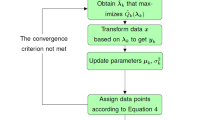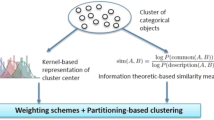Abstract
The k-means algorithm is well known for its efficiency in clustering large data sets. However, working only on numeric values prohibits it from being used to cluster real world data containing categorical values. In this paper we present two algorithms which extend the k-means algorithm to categorical domains and domains with mixed numeric and categorical values. The k-modes algorithm uses a simple matching dissimilarity measure to deal with categorical objects, replaces the means of clusters with modes, and uses a frequency-based method to update modes in the clustering process to minimise the clustering cost function. With these extensions the k-modes algorithm enables the clustering of categorical data in a fashion similar to k-means. The k-prototypes algorithm, through the definition of a combined dissimilarity measure, further integrates the k-means and k-modes algorithms to allow for clustering objects described by mixed numeric and categorical attributes. We use the well known soybean disease and credit approval data sets to demonstrate the clustering performance of the two algorithms. Our experiments on two real world data sets with half a million objects each show that the two algorithms are efficient when clustering large data sets, which is critical to data mining applications.
Similar content being viewed by others
References
Anderberg, M.R. 1973. Cluster Analysis for Applications. Academic Press.
Ball, G.H. and Hall, D.J. 1967. A clustering technique for summarizing multivariate data. Behavioral Science, 12:153–155.
Bezdek, J.C. 1981. Pattern Recognition with Fuzzy Objective Function. Plenum Press.
Bobrowski, L. and Bezdek, J.C. 1991. c-Means clustering with the l 1 and l ∞ norms. IEEE Transactions on Systems, Man and Cybernetics, 21(3):545–554.
Cormack, R.M. 1971. A review of classification. J. Roy. Statist. Soc. Serie A, 134:321–367.
Dubes, R. 1987. How many clusters are best? An experiment. Pattern Recognition, 20(6):645–663.
Dubes, R. and Jian, A.K. 1979. Validity studies in clustering methodologies. Pattern Recognition, 11:235–254.
Ester, M., Kriegel, H.P., Sander, J., and Xu, X. 1996. A density-based algorithm for discovering clusters in large spatial databases with noise. Proceedings of the 2nd International Conference on Knowledge Discovery and Data Mining, Portland, Oregon, USA: AAAI Press, pp. 226–231.
Everitt, B. 1974. Cluster Analysis. Heinemann Educational Books Ltd.
Fisher, D.H. 1987. Knowledge acquisition via incremental conceptual clustering. Machine Learning, 2(2):139–172.
Gowda, K.C. and Diday, E. 1991. Symbolic clustering using a new dissimilarity measure. Pattern Recognition, 24(6):567–578.
Gower, J.C. 1971. A general coefficient of similarity and some of its properties. BioMetrics, 27:857–874.
Huang, Z. 1997a. Clustering large data sets with mixed numeric and categorical values. Proceedings of the First Pacific Asia Knowledge Discovery and Data Mining Conference, Singapore: World Scientific, pp. 21–34.
Huang, Z. 1997b. A fast clustering algorithm to cluster very large categorical data sets in data mining. Proceedings of the SIGMOD Workshop on Research Issues on Data Mining and Knowledge Discovery, Dept. of Computer Science, The University of British Columbia, Canada, pp. 1–8.
IBM. 1996. Data Management Solutions. IBM White Paper, IBM Corp.
Jain, A.K. and Dubes, R.C. 1988. Algorithms for Clustering Data. Prentice Hall.
Kaufman, L. and Rousseeuw, P.J. 1990. Finding Groups in Data—An Introduction to Cluster Analysis. Wiley.
Klosgen, W. and Zytkow, J.M. 1996. Knowledge discovery in databases terminology. Advances in Knowledge Discovery and Data Mining, U.M. Fayyad, G. Piatetsky-Shapiro, P. Smyth, and R. Uthurusamy (Eds.), AAAI Press/The MIT Press, pp. 573–592.
Kodratoff, Y. and Tecuci, G. 1988. Learning based on conceptual distance. IEEE Transactions on Pattern Analysis and Machine Intelligence, 10(6):897–909.
Lebowitz, M. 1987. Experiments with incremental concept formation. Machine Learning, 2(2):103–138.
MacQueen, J.B. 1967. Some methods for classification and analysis of multivariate observations. Proceedings of the 5th Berkeley Symposium on Mathematical Statistics and Probability, pp. 281–297.
Michalski, R.S and Stepp, R.E. 1983. Automated construction of classifications: Conceptual clustering versus numerical taxonomy. IEEE Transactions on Pattern Analysis and Machine Intelligence, 5(4):396–410.
Milligan, G.W. 1981. A Monte Carlo study of thirty internal criterion measures for cluster analysis. Psychometrika, 46(2):187–199.
Milligan, G.W. 1985. An algorithm for generating artificial test clusters. Psychometrika, 50(1):123–127.
Milligan, G.W. and Cooper, M.C. 1985. An examination of procedures for determining the number of clusters in a data set. Psychometrika, 50(2):159–179.
Milligan, G.W. and Isaac, P.D. 1980. The validation of four ultrametric clustering algorithms. Pattern Recognition, 12:41–50.
Ng, R.T. an d Han J. 1994. Efficient and effective clustering methods for spatial data mining. Proceedings of the 20th VL DB Conference, Santiago, Chile, pp. 144–155.
Quinlan, J.R. 1993. C4.5: Programs for Machine Learning. Morgan Kaufmann Publishers.
Ralambondrainy, H. 1995. A conceptual version of the k-means algorithm. Pattern Recognition Letters, 16:1147–1157.
Ruspini, E.R. 1969. A new approach to clustering. Information Control, 19:22–32.
Ruspini, E.R. 1973. New experimental results in fuzzy clustering. Information Sciences, 6:273–284.
Selim, S.Z. and Ismail, M.A. 1984. k-Means-type algorithms: A generalized convergence theorem and characterization of local optimality. IEEE Transactions on Pattern Analysis and Machine Intelligence, 6(1):81–87.
Williams, G.J. and Huang, Z. 1996. A case study in knowledge acquisition for insurance risk assessment using a KDD methodology. Proceedings of the Pacific Rim Knowledge Acquisition Workshop, Dept. of AI, Univ. of NSW, Sydney, Australia, pp. 117–129.
Zhang, T., Ramakrishnan, R., and Livny, M. 1996. BIRCH: An efficient data clustering method for very large databases. Proceedings of ACM SIGMOD Conference, Montreal, Canada, pp. 103–114.
Author information
Authors and Affiliations
Rights and permissions
About this article
Cite this article
Huang, Z. Extensions to the k-Means Algorithm for Clustering Large Data Sets with Categorical Values. Data Mining and Knowledge Discovery 2, 283–304 (1998). https://doi.org/10.1023/A:1009769707641
Issue Date:
DOI: https://doi.org/10.1023/A:1009769707641




